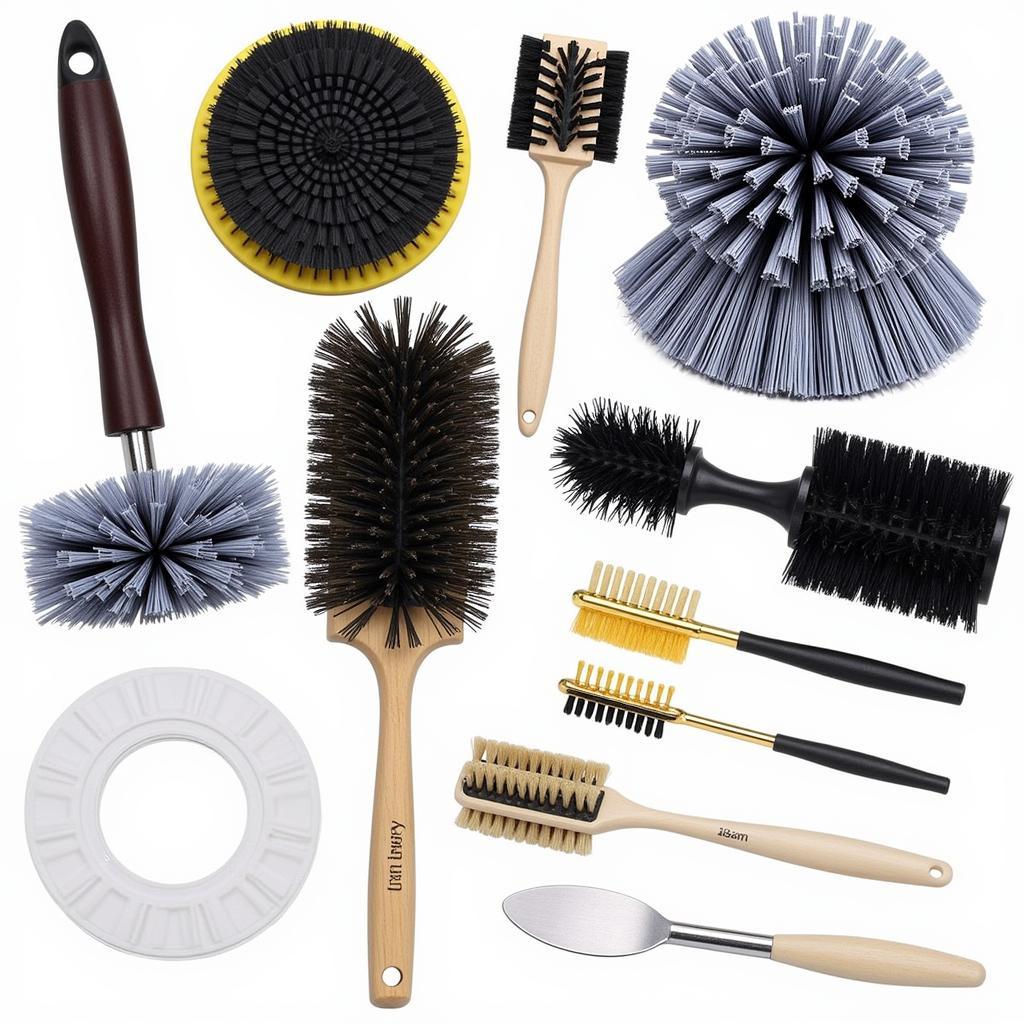Choosing the Best Car Detail Brush To Use can be the difference between a good detailing job and a truly professional finish. With so many options available, it’s easy to get overwhelmed. This guide will equip you with the knowledge to choose the perfect brushes for every nook and cranny of your car.
Why You Need Dedicated Car Detail Brushes
You might be wondering, “Can’t I just use an old toothbrush?” While a toothbrush might work in a pinch, dedicated car detailing brushes are designed specifically for the task. Here’s why:
- Gentle on Delicate Surfaces: Car detail brushes use soft, non-abrasive bristles that effectively lift dirt and grime without scratching paint, leather, or vinyl.
- Reach Tight Spaces: Detailing brushes come in various shapes and sizes to access hard-to-reach areas like air vents, emblems, and around trim.
- Improved Cleaning Power: The specific bristle design and density provide deeper cleaning compared to general-purpose brushes.
Types of Car Detailing Brushes and Their Uses
 Different Types of Detailing Brushes
Different Types of Detailing Brushes
Navigating the world of car detail brushes is easy once you understand their specific purposes:
- Wheel Brushes: These brushes feature long handles and durable bristles for cleaning wheels, tires, and wheel wells. Look for brushes with angled heads for better access to tight spots behind spokes.
- Interior Brushes: These brushes are softer than wheel brushes and ideal for delicate surfaces like leather seats, dashboards, and door panels. They often have shorter handles for better control.
- Detailing Brushes: These smaller brushes are perfect for tight spaces like air vents, badges, and around buttons. They come in various shapes and sizes, including round, flat, and pointed brushes.
- Scrubbing Brushes: These brushes have stiffer bristles and are designed for cleaning heavily soiled areas like floor mats and carpets. Use caution when using these on delicate surfaces.
Choosing the Right Bristle Material
The bristle material is crucial in determining the brush’s effectiveness and safety on your car’s surfaces:
- Boar’s Hair Brushes: The softest and most delicate option, ideal for use on leather, wood, and highly polished surfaces.
- Natural Fiber Brushes: Durable and versatile, natural fiber brushes are suitable for cleaning various interior and exterior surfaces.
- Synthetic Bristles: These bristles are resistant to chemicals and ideal for use with strong cleaners. They come in various stiffness levels for different applications.
- Microfiber Brushes: Super soft and absorbent, microfiber brushes are excellent for dusting and removing fingerprints without scratching.
Best Detailing Vacuum for Car: Our Top Picks for a Spotless Interior
Tips for Using Car Detailing Brushes
- Always work in a well-lit area to see the dirt and grime clearly.
- Use the right brush for the job. Avoid using harsh brushes on delicate surfaces.
- Work in small sections and apply gentle pressure to avoid damaging the surface.
- Rinse the brush frequently to remove dirt and prevent cross-contamination.
- Store your brushes properly in a clean, dry place to maintain their shape and longevity.
Expert Insight
“Using the right brush can be a game-changer for your detailing results,” says John Smith, a professional detailer with over 15 years of experience. “Investing in quality brushes and learning how to use them correctly will save you time and effort while delivering professional-looking results.”
Conclusion
Choosing the best car detail brush to use doesn’t have to be complicated. By understanding the different types of brushes, bristle materials, and proper cleaning techniques, you can achieve a showroom-worthy shine for your vehicle.
FAQs
Q: How often should I replace my car detail brushes?
A: It depends on the frequency of use and how well you care for them. However, it’s generally a good idea to replace brushes every 6-12 months or sooner if you notice bristle damage or loss of effectiveness.
Q: Can I use dish soap to clean my car detail brushes?
A: While you can use dish soap, it’s best to use a dedicated brush cleaner specifically designed for detailing brushes. These cleaners help break down dirt, grime, and product build-up without damaging the bristles.
Q: What’s the best way to dry my car detail brushes?
A: After rinsing your brushes thoroughly, gently squeeze out excess water. Avoid pulling or twisting the bristles. Hang them upside down to air dry completely before storing.
Q: Can I use the same brush for my interior and exterior?
A: It’s not recommended. Using separate brushes for interior and exterior cleaning helps prevent cross-contamination and ensures you’re using the appropriate brush for the specific surface.
Q: What’s the best way to clean brushes with heavy product build-up?
A: Soak the brush in a solution of warm water and brush cleaner for 30 minutes. Work the bristles gently with your fingers to loosen the build-up. Rinse thoroughly and allow them to air dry completely.
Need Help Choosing the Perfect Detailing Brushes?
Contact us via WhatsApp: +1(641)206-8880, or email: [email protected]. Our 24/7 customer support team is here to help you find the perfect tools for the job!

Leave a Reply